In today’s increasingly digital landscape, businesses of all sizes are becoming more dependent on technology. While this transformation offers numerous benefits, it also opens the door to cyber threats that can jeopardize sensitive data, financial assets, and customer trust. Cybersecurity is no longer just an IT concern; it’s a critical aspect of business strategy that must be managed at all levels of an organization. In this article, we explore why cybersecurity is vital for businesses and offer key strategies for safeguarding your operations in a digital world.
1. The Rising Threat of Cybercrime

As businesses rely more on digital tools and platforms, cybercriminals are becoming more sophisticated in their methods of attack. Cyberattacks such as phishing, ransomware, and data breaches are common threats that can cause significant financial and reputational damage. A single attack can lead to the loss of confidential customer information, financial data, or intellectual property.
Key Threats to Business Security:
- Phishing Attacks: Fraudulent emails or websites that trick employees into revealing sensitive information.
- Ransomware: Malicious software that locks critical data and demands payment for its release.
- Data Breaches: Unauthorized access to confidential business or customer data.
- Denial-of-Service (DoS) Attacks: Overloading a system with traffic to make it unavailable to users.
2. The Importance of a Cybersecurity Strategy
A strong cybersecurity strategy goes beyond using antivirus software. It involves creating a comprehensive plan to protect your organization’s digital assets, identifying vulnerabilities, and responding to potential attacks. It should be a dynamic process, regularly updated to address new threats.
Key Components of a Cybersecurity Strategy:
- Risk Assessment: Identifying critical assets and understanding the potential vulnerabilities.
- Employee Training: Educating staff on best practices for security and recognizing potential threats.
- Incident Response Plan: A clear plan for how to respond if an attack occurs, minimizing damage and restoring operations.
- Regular Updates and Patches: Keeping software up to date to protect against known vulnerabilities.
3. Implementing Strong Access Controls
Access control is one of the most effective ways to protect your business. By limiting who can access sensitive data and systems, you reduce the risk of unauthorized users gaining access. This can be done through tools like role-based access control (RBAC) and multi-factor authentication (MFA), which ensure that only authorized personnel can view or modify critical business information.
Key Access Control Measures:
- Role-Based Access Control (RBAC): Assigning permissions based on an employee’s role within the company.
- Multi-Factor Authentication (MFA): Requiring users to provide more than one form of identification (e.g., a password and a code sent to their phone) to access systems.
- Least Privilege Principle: Giving users the minimum level of access necessary to perform their job functions.
4. Protecting Customer Data
Customer data is often the most valuable asset for businesses, making it a prime target for cybercriminals. Ensuring the confidentiality and integrity of customer information is not only essential for protecting your reputation but is also required by various data protection regulations, such as GDPR and CCPA.
Steps to Protect Customer Data:
- Encryption: Encrypt sensitive data to make it unreadable to unauthorized individuals.
- Data Minimization: Only collect and store the minimum amount of personal data necessary for business operations.
- Secure Storage: Store data in secure, access-controlled environments with regular backups to prevent data loss.
- Compliance: Ensure your business complies with data protection laws and regulations, such as GDPR or CCPA.
5. Network Security
Your business network is the backbone of your operations. Protecting it from internal and external threats is critical. Firewalls, intrusion detection systems, and secure Wi-Fi protocols are essential tools for safeguarding your network. Additionally, segmenting your network can limit the potential damage if an attack occurs.
Network Security Best Practices:
- Firewalls: Use firewalls to prevent unauthorized access to your business network.
- Intrusion Detection Systems (IDS): Monitor your network for unusual or suspicious activity.
- VPNs (Virtual Private Networks): Allow remote workers to access your network securely by encrypting their internet connection.
- Network Segmentation: Divide your network into segments to limit the spread of an attack.
6. Regular Backups and Disaster Recovery
No matter how robust your cybersecurity measures are, it’s essential to prepare for the worst-case scenario. Regular backups of your critical data ensure that your business can recover quickly in the event of a cyberattack or data loss. A disaster recovery plan outlines the steps necessary to restore operations, minimizing downtime and protecting business continuity.
Key Elements of a Backup and Disaster Recovery Plan:
- Regular Backups: Perform frequent backups of critical data and store them securely, either on-site or in the cloud.
- Disaster Recovery Plan: Develop a detailed recovery plan to guide the response in case of a cyberattack or data breach.
- Testing: Regularly test backups and recovery plans to ensure they will function effectively when needed.
7. Cybersecurity in the Cloud
As businesses increasingly rely on cloud computing for storing and processing data, securing cloud environments becomes paramount. While cloud providers often offer robust security measures, businesses must take steps to protect their data within the cloud, including configuring settings properly, encrypting sensitive data, and monitoring usage.
Cloud Security Best Practices:
- Cloud Provider Security: Ensure your cloud provider follows strict security protocols and complies with relevant standards.
- Encryption: Encrypt data before uploading it to the cloud to protect it in transit and at rest.
- Access Control: Implement strict access control measures to limit who can access cloud resources.
- Monitoring: Continuously monitor cloud environments for signs of suspicious activity.
8. The Role of Cybersecurity Culture
Building a culture of cybersecurity within your organization is crucial for protecting your business. Employees should be regularly trained on security protocols and encouraged to adopt best practices, such as strong password policies and caution when opening emails or clicking on links. A proactive approach to cybersecurity involves every member of the organization, not just the IT department.
Building a Cybersecurity Culture:
- Employee Awareness: Train employees on the latest cybersecurity threats and best practices.
- Leadership Involvement: Ensure that top management prioritizes cybersecurity as a strategic concern.
- Encourage Reporting: Establish a clear process for employees to report security incidents or suspicious activities.
Conclusion
As businesses continue to integrate technology into every aspect of their operations, cybersecurity must remain a top priority. By implementing a robust cybersecurity strategy, protecting customer data, and fostering a culture of security awareness, businesses can safeguard their operations from the growing threat of cybercrime. In a digital world, protecting your business is not only a matter of compliance, but a commitment to maintaining customer trust and ensuring long-term success.
FAQs
What is the most common type of cyberattack on businesses?
Phishing attacks are the most common type of cyberattack. Cybercriminals often use deceptive emails or websites to trick employees into revealing sensitive information, such as passwords or financial details.
How can I tell if my business has been hacked?
Signs that your business may have been hacked include unusual system behavior, slow performance, unauthorized access to data, and missing or altered files. It’s important to have monitoring systems in place to detect any suspicious activity.
What should I do if my business falls victim to a cyberattack?
Immediately isolate affected systems, inform your cybersecurity team or an external expert, and follow your incident response plan. Notify customers if their data has been compromised and work on restoring your systems from backups.
How can I secure my remote workforce?
To secure a remote workforce, use VPNs, enable multi-factor authentication, and educate employees on best practices for cybersecurity, such as avoiding unsecured public Wi-Fi and phishing scams.
Is cybersecurity only the responsibility of the IT department?
No, cybersecurity is everyone’s responsibility. While the IT department manages technical security measures, employees must be trained to recognize threats and follow company policies to ensure the overall safety of the organization.


